Echo, Delay, and Voice Quality Analysis
Over Wireless and Wired Networks
04th, Sep 2018
Welcome to the September 2018 issue of GL Communications’ Newsletter providing information and insight into our Echo Measurement Utility Software (EMU) that measures Echo Path Delay (EPD) and Echo Return Loss (ERL) of voice calls. Echo can be as simple as sidetone, or more complex such as line echo or acoustic echo. The EMU when combined with GL’s VQuad™, T1 E1 Analyzers, MAPS™ Emulators, or Voiceband Analyzer, additional voice quality metrics such as round-trip delay (RTD), voice quality, and noise can also be measured.
Overview
A voice call may transit a variety of networks - Mobile, VoIP, TDM, and others.
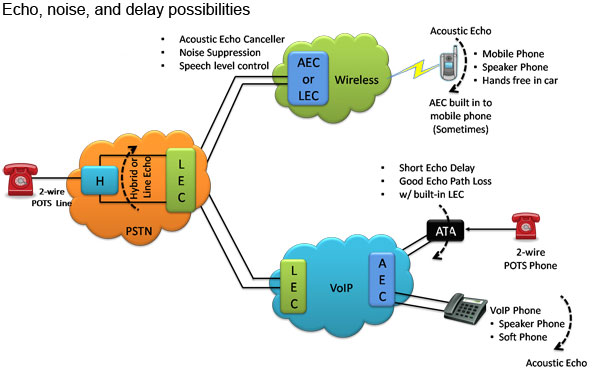
A typical call can have many of the following characteristics that can affect quality:
- narrowband (8 kbps) or wideband call (> 64 kbps)
- end-to-end digital but with D/D conversions (codec conversions)
- many D/A and A/D conversions
- additive noise and/or background noise
- speech level variations
- variable delay
- echo in the form of sidetone, line echo, or acoustic echo
- signaling and voiceband conversions that affect DTMF, FAX, and MODEM transmissions
- packet delay, loss, sequencing, and duplications
Echo Measurement Utility
To provide a comprehensive assessment of voice quality irrespective of network type, GL has various tools combined together into one integrated platform consisting of VQuad™, Dual UTA HD, T1 E1, and WebViewer™. This platform provides the ability to make VoIP, TDM, and Mobile calls from any fixed or mobile location. All interface flexibility is provided (2-Wire, 4-Wire, VoIP, TDM, and Mobile) within the Dual UTA and USB T1 E1 Analyzer. In addition, VQuad™ provides algorithms for signaling, voice transmission, and voice quality assessment. WebViewer™ provides the central point where voice metrics are stored and displayed through a WEB interface.
GL’s Echo Measurement Utility (EMU) software within this architecture provides a means to assess sidetone, line, and acoustic echo and corresponding delays. EMU is an offline adjunct analysis application (under control of VQuad™, or as stand-alone) that compares the source and received files to determine echoes and delay of echoes.
As shown above, the EMU requires only two files to function - the sending file and simultaneously recorded received file. Any tool that achieves this can be used with the EMU.
EMU provides delay and ERL measurements for all detected echoes, along with an ‘ERL vs Delay’ plot where each echo is depicted within the plot. One can zoom-in on a particular echo to gauge overall echo impairments. In addition, the application includes signal graphs for source signal, received signal, error signal, and adaptive filter coefficients.
GL’s EMU can also seamlessly work with other GL intrusive tools such as MAPS™ Emulators and T1 E1 Analyzers.
- For VoIP - VQuad™ or MAPS™ SIP
- For Mobile Phones - VQuad™ with Dual UTA HD or MAPS™ Emulators
- For TDM - VQuad™ with USB T1 E1 unit, or Any T1 E1 Analyzer (Octal/Quad T1 E1, tProbe™ T1 E1 unit, tScan16™, Dual PCIe T1 E1 Card)
- For 2-Wire - VQuad™ with Dual UTA HD, tProbe™ FXO FXS
- For 4-Wire - VQuad™ with Dual UTA HD, or Any T1 E1 Analyzer (Octal/Quad T1 E1, tProbe™ T1 E1 unit, tScan16™, Dual PCIe T1 E1 Card)
Call Scenarios - Line (Hybrid) Echo Analysis
Following are few of the important real-time scenarios where Line (Hybrid) Echo and Acoustic Echo analysis can be done using EMU, when used with VQuad™ and/or MAPS™ Emulator. These tools allow to send and receive voice files for Echo measurement across various network types.
- PSTN-to-PSTN Setup
- PSTN-to-Mobile Setup
- PSTN (direct to gateway)-to-VoIP Phone Setup
- PSTN (through class5 T1 E1 Switch)-to-VoIP Phone Setup
- PSTN (through class5 T1 E1 Switch)-to-VQuad Software (Ethernet Interface) Setup
- PSTN (direct to gateway)-to-VQuad Software (Ethernet Interface) Setup
- Mobile Phone-to-Mobile Phone Setup
- Mobile Phone-to-VoIP Phone Setup
- VQuad™ (Ethernet Interface)-to-IP PBX-to-PSTN Setup
- VoIP Phone-to-IP PBX-to-PSTN Setup
For comprehensive information on the each of the above testing scenario, you can visit Testing Scenarios section.
Main Features:
- Echo, delay, and voice quality analysis of voice calls in VoIP, TDM, 2Wire, 4Wire, and Mobile networks
- Measures EPD in msec and ERL in dB
- Compares source and received files to determine maximum of 4 echoes
- Ability to automate the entire test process using scripting including sending the results to the central database for access via web-based clients
- Automatically detects the incoming degraded voice files, performs meaurements, and sends the measurements to a database after analysis
- Detailed offline analysis
- Detect Acoustic/Line (Hybrid) echoes and evaluate intermittent echoes
- Graphically displays source signal, received signal, error signal, and adaptive filter coefficients
- Allows zoom-in on each graph, and exporting snapshot of these graphs to a file for later analysis
- Calculates adaptive filter coefficients and echo characteristics for the error signal
- Speaker option to play the audio files (intrusive and non-intrusive)
- Option to zoom-in on any particular echo to investigate further
VQuad™ with Dual UTA HD
The EMU can be used effectively with different hardware/software to support nearly any network interface. The figure below depicts EMU working with VQuad™/ Dual UTA intrusive tool. VQuad™ software along with the Dual UTA hardware supports transmitting and receiving files across the following interfaces: RJ11 2-wire analog, 3.5 mm jack for mobile headset connection, Handset phones and balanced I/O for VoIP soft phones.
In addition, VQuad™ provides the capability to remotely control the EMU through scripting, thus, automating the entire testing process including sending results to the central database for access via GL’s WebViewer™.
MAPS™ SIP or VQuad™ with VoIP option
GL’s MAPS™ Emulator or VQuad™ with VoIP option can be used with EMU to assess line or acoustic echo.
T1 E1 Analysers or VQuad™ with T1 E1 Option
GL’s T1 E1 Analysis application (requires hardware) is used with EMU to detect possible echoes through a T1 E1 channel. Through MAPS™ scripting or VQuad™ with T1 E1 option, it is possible to automate the entire testing process including sending and receiving files. The intrusive files and the received files are fed as input to EMU for further analysis.
Results
The Operator information option is used to print the result in spread sheet. The generated “Result” spread sheet includes operator information, file information, echo characteristics, and snapshots of all the signal graphs.

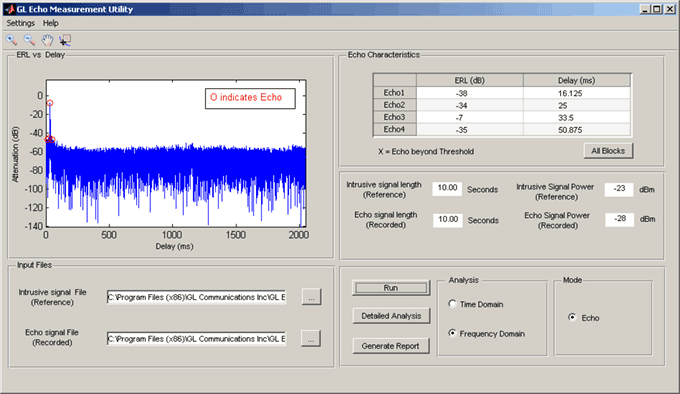
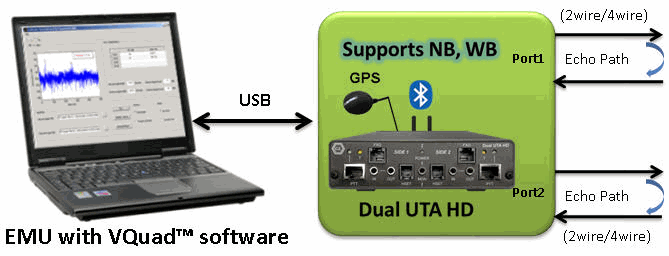

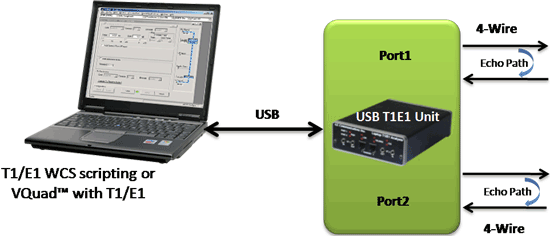
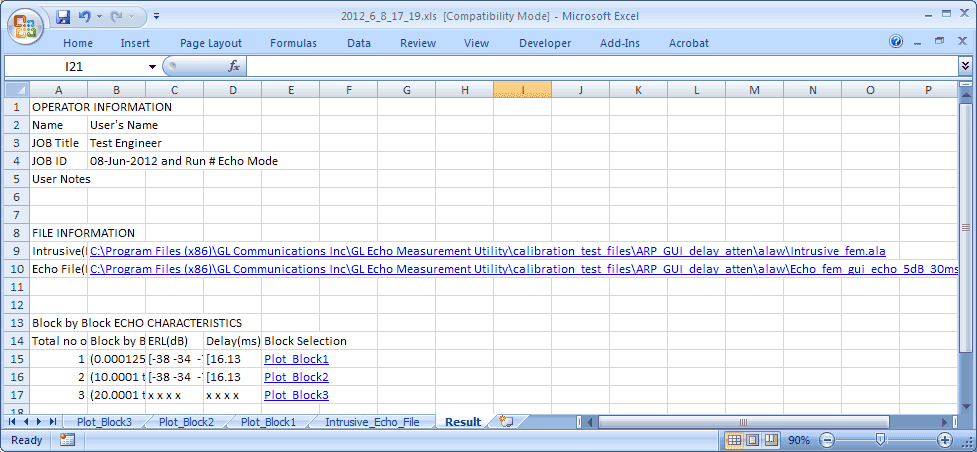

 Back to Newsletter Index Page
Back to Newsletter Index Page